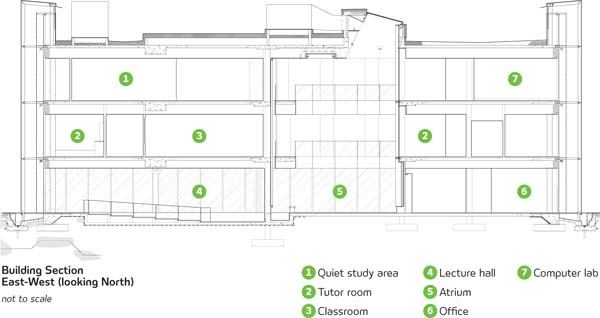Finishes, furnishings, and lighting throughout the center follow the school’s green-and-yellow color palette. In the atrium, adjustable RGB 50W LED color-wash fixtures tuck into skylight wells and into ceiling pockets. They run with the linear, tubular neonlike color-changing LEDs (10W per foot) in the glazed elevator shaft, so that there is a continual interplay between bright yellow and grassy green. In the auditorium, 28W miniature T5 fluorescents provide linear accent lighting along the window walls. Color comes from one row of 4100K LEDs that uplight a sheet of stainless steel, laser cut with donor names.
Interface Engineering’s approach to the learning areas and offices was more subdued. Large-shaded custom 42W compact fluorescent pendants hang over study tables in the tutor rooms and simple task fixtures illuminate the library. Both the study carrels and office cabinetry are customized with built-in 28W T8 undercabinet fluorescents. Narrow-aperture 28W T5 recessed fluorescent luminaires are used in all of the corridors. All lighting is tied back to a master control system.
Oregon has one of the most progressive energy codes in the country, following the State Energy Efficiency Design (SEED) program, established in 1991. In addition, all state buildings must use 20 percent less energy on an annual basis than a similar building constructed to meet the Oregon Energy Code. The Jaqua Center’s all-glass façade makes this even more difficult to meet. Occupancy sensors and photocells adjust for available daylight and usage. Motorized shades, mounted within the double skin, address visual glare and heat gain.
The design team also used EQuest energy-modeling software from the U.S. Department of Energy to define lighting zones, customize time of use, and create occupancy models. Using the software, the engineers determined lighting loads based not on an accounting of connected loads, which has been the de facto practice, but rather on usage in kilowatt-hours, which provides a more accurate reading of actual energy usage. By applying this model, Interface’s engineers were able to fine-tune the center’s performance. For example, the fluorescent corridor lighting is on programmable dimmable ballasts, and software keeps the energy loading at a maximum of 75 percent of the typical connected load.
With these efforts, the building comes in at 20 percent below the Oregon Energy Code. So for the whole design team, the project was a touchdown.
In the Jaqua Center’s atrium (top right), LEDs illuminate the many artistic installations honoring the University of Oregon’s student athletes and alumni. Each application is unique. The Pac-10 wall (top left) combines linear and spotlight fixtures, while the Einstein mural (bottom left) uses recessed linear LEDs along the artwork’s edges. Color-changing LEDs in the auditorium (bottom right) bathe donor names in the school colors.
The glowing façade comes from LED accent fixtures installed within the building envelope. Light grazes the elegant support structure and stainless steel screens. A 5-foot-deep air cavity within the glazed curtainwall (top) provides space for lighting and a series of operable rolling shades that help modulate direct sunlight and heat gain. Study areas and the café (bottom) are primarily daylit, with specific tasklighting. •
Details Project: John E. Jaqua Academic Center for Student Athletes, University of Oregon, Eugene, Ore.
Donor: Phil and Penny Knight, Portland, Ore.
Owner: University of Oregon, Eugene, Ore.
Architect: ZGF Architects, Portland, Ore.
Lighting Designer: Interface Engineering, Portland, Ore.
Interior Designer: Firm 151, Portland, Ore.
Project Cost: $41.7 million
Project Size: 40,000 square feet
Watts Per Square Foot: 0.998 watts (connected load)
Energy Code Compliance: Exceeds Oregon Energy Code; Exceeds Oregon State Energy Efficiency Design (SEED) program requirements; Energy model exceeds a code-minimum building by 9 percent; Lighting system operates at 25 percent to 50 percent below Oregon Energy Code
Manufacturers/Applications: Artemide (custom pendants), Axis (egress lighting at stairwells), B-K Lighting (landscape path lighting), Concealite Life Safety Products (concealed egress luminaire), Cooper Lighting Lumière (exterior landscape lighting), Cooper Lighting Fail-Safe (emergency lighting), Cooper Lighting Metalux (back-of-house spaces), Cooper Lighting RSA Lighting (multiple lamp slot luminaire), Cooper Lighting Sure-Lites (egress and exit signs), Deltalight (linear LED), Dreamscape Lighting Mfg. (in-wall slot luminaire), Edison Price Lighting (square downlights), Erco (small linear fixture at open stair), Focal Point (general fluorescent lighting), Gammalux Systems (general fluorescent lighting), Gotham Lighting (CFL downlight, back-of-house spaces), HessAmerica (exterior path and parking lighting), Hunza (exterior path lights), Hydrel (interior LED uplights), i-Led Solutions (small LED “points” at restrooms), Ingo Maurer (custom fixture at deli counter), Jesco Lighting Group (niche, cove, furniture, and detail lighting), Juno Lighting Group by Schneider Electric (back-of-house spaces), Lighting Services Inc. (track, monopoints atrium downlights), Linear Lighting (general fluorescent lighting), Lumux (exterior utility luminaire), Lutron (Ecosystem and Quantum lighting control systems), Osram Sylvania (lamps throughout), Philips Bronzelite (tree uplights), Philips Color Kinetics (white and color-changing LED), Philips Guth (back-of-house spaces), The Lighting Quotient (indirect lighting open stair), Tivoli (exterior LED rope light), WAC Lighting (small downlights), Zumtobel (general fluorescent lighting)
